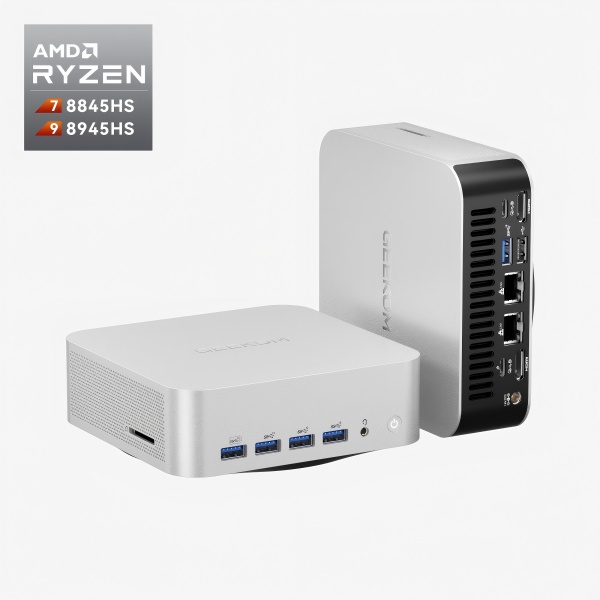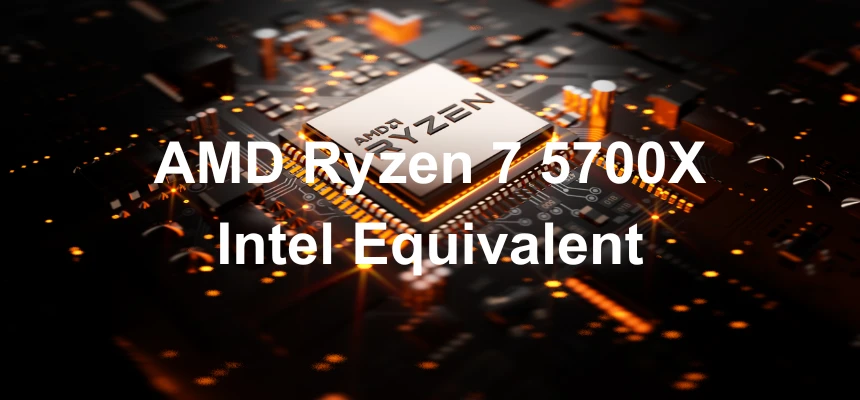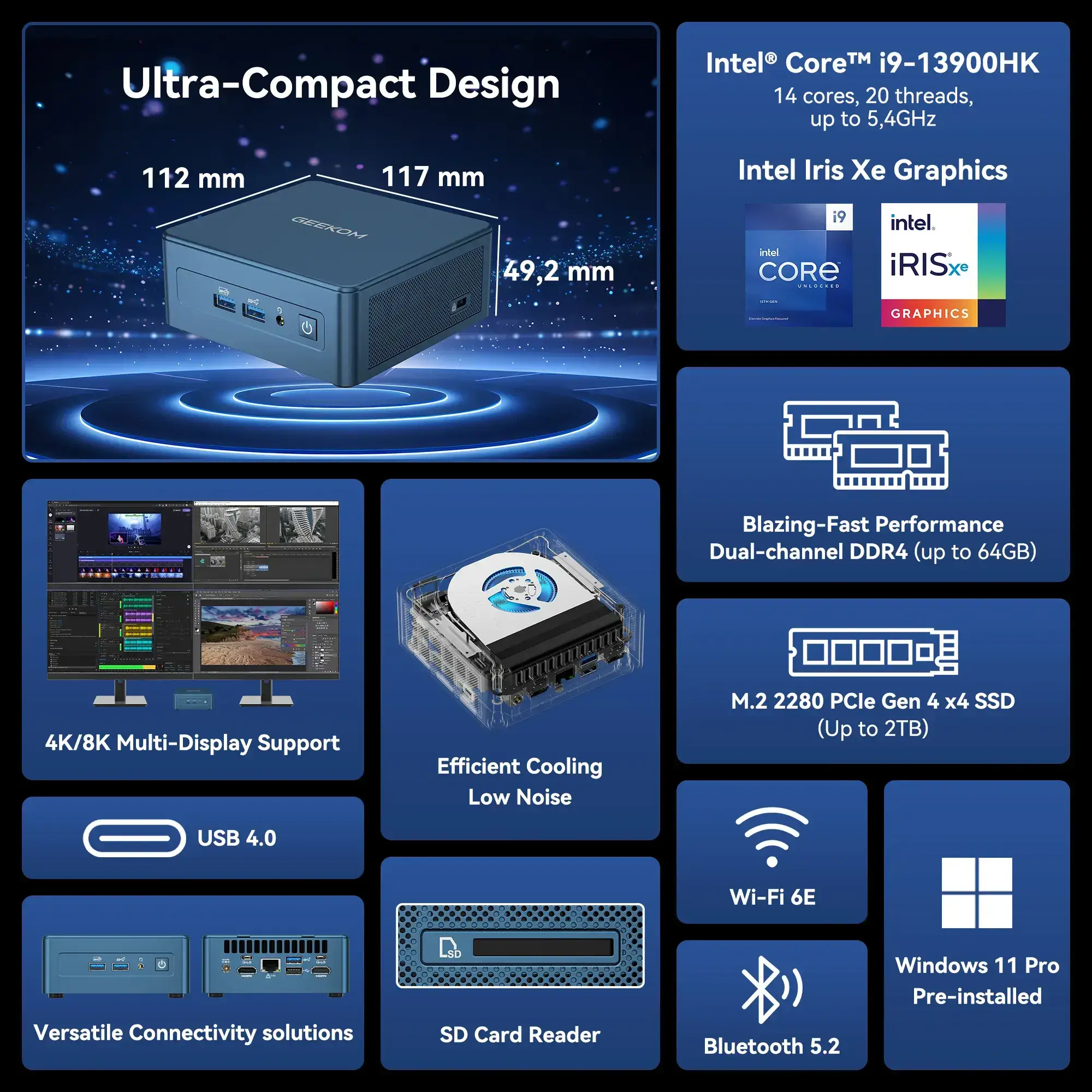Introduction
AMD Ryzen 7 5700X is among a few top-performing processors in AMD’s Ryzen collection that are geared for users with advanced multitasking requirements, maximum gaming performance, and energy efficiency. Based on AMD’s Zen 3 architecture, the Ryzen 7 5700X sports 8 cores and 16 threads—the perfect processor for demanding tasks such as video editing, 3D rendering, and software development. With a base clock speed of 3.4 GHz and the ability to boost to around 4.6 GHz, the chip is well-balanced between consuming more power and remaining efficient.
On the Intel end, processors such as Intel Core i7-11700K and Intel Core i5-12600K are deemed to be the nearest equivalents to the Ryzen 7 5700X. They also offer impressive multi-core performance and cater to the same bunch of audiences—that’s gamers, content creators, and professionals. The comparison between AMD and Intel invariably lies based on performance, power efficiency, and price-to-performance ratio, and it is very important to look at both offerings individually.
In this article, we shall consult a detailed comparison of the Ryzen 7 5700X and its equivalents from Intel, spanning performance metrics, features of a CPU, gaming results, power usage, and returns for money.
AMD Ryzen 7 5700X Benchmark Comparisons
Benchmarks provide a clear focus on the strengths and weaknesses of the Ryzen 7 5700X and its analogs, notably the Intel Core i5-12600K, across a wide selection of cases. There are several benchmarking tools such as PassMark, CPU Mark, and other synthetic benchmarks that can be employed to evaluate single-thread and multi-core performance which come in handy for consumers to make practical decisions based on their workload.
1. Benchmark Scores
The table below summarizes various results for AMD Ryzen 7 5700X when compared with Intel’s Core i5-12600K and i7-11700k. Among these tests, are those for single-thread performance, multi-core performance, and scores of various synthetic benchmarks, including CPU Mark and PassMark.
| Processor | Single-Thread Performance (CPU Mark) | Multi-Core Performance (PassMark) | Base Clock | Boost Clock | TDP | Architecture |
|---|---|---|---|---|---|---|
| AMD Ryzen 7 5700X | 3,490 | 22,500 | 3.4 GHz | 4.6 GHz | 65W | Zen 3 (Vermeer) |
| Intel Core i5-12600K | 4,290 | 25,500 | 3.7 GHz | 4.9 GHz | 125W | Alder Lake |
| Intel Core i7-11700K | 3,940 | 23,600 | 3.6 GHz | 5.0 GHz | 125W | Rocket Lake |
Single-threaded performance: The i5 based on Intel’s 12th-generation Alder Lake architecture shows a very slight lead over the Ryzen 7 5700X in games and lighter productivity programs that benefit from high single-thread speeds. Intel Turbo Boost Technology makes the clock-speed adjustment dynamic in an effort to get enhanced performance under continuous heavy loads.
Multi-core performance: The Intel Core i5-12600K distinguishes itself from the Ryzen 7 5700X when it comes to rendering work, be it video editing, rendering, or something along software development, and this is mainly due to its hybrid core architecture (Alder Lake). The AMD challenger holds its own with regard to performance, giving the user a balanced bracket of single-hitting and multi-core power, courtesy of the Zen 3.
2. Performance Analysis
Single-core Performance: The i5-12600K’s outstanding single-thread performance is borne out by its CPU Mark score of 4,290. Because this CPU has high clock speeds needed for workloads, particularly in lower-resolution gaming (1080p) or lighter workloads that cannot fully utilize multi-core processing, it has an edge over those types of workloads. Intel Turbo Boost Technology allows the CPU to ramp its speed when necessary, thus helping it achieve elevated performance in this area.
Multi-core Performance: While the other CPUs offer significantly lower TDPs, having 65 and 70W, respectively, the i5-12600K is leading with 25,500 on the PassMark multi-core performance rating. The Ryzen 7 5900X is Zen 3 architecture, which is the workhorse of AMD’s Vermeer lineup, which is cemented mainly on performing highly parallel multi-threaded operations. Thus, the Ryzen 7 5900X will have an advantage if one needs higher multi-core performance without taking an unnecessarily high amount of power.
Synthetic Benchmarks: In fact, the architecture and high clock speeds enable this processor to give much higher overall scores on synthetic benchmarks such as PassMark. However, the Ryzen 7 5700X still manages to provide good performance in multi-thread scenarios, even in workloads able to fully take advantage of its 8 cores and 16 threads.
3. Thermal Design Power (TDP) and Power Efficiency
The TDP of the Intel Core i5-12600K is much higher than that of the Ryzen 7 5700X. The Ryzen 7 5700X consumes only 65W of power, making the processor capable of using less power for work, therefore, it would be of great use to the user who is running an operating system that is reasonably quiet and has its own cooling features. The Intel Core i5-12600K, on the contrary, carries a TDP of 125W, demanding more robust cooling solutions, especially when the processor is operating at its boost clock of 4.9GHz.
Which Is Better?
When it comes to benchmarking, the Intel Core i5-12600K outshines the Ryzen 7 5700X in both single-thread and multi-thread tests, attributed mostly to its higher base boost clock speeds and greater power consumption. Nonetheless, the Ryzen 7 5700X remains a potent contender, touting multi-core performance with better power efficiency. There are advantages to either processor depending on gaming versus content creation or casual computer use.
Geared towards single-thread performance users and gamers, the offerings of Intel are perchance more attractive, while a balanced compromise between multi-core efficiency and lower power consumption dynamic remains from the perspective of Ryzen 7 5700X.
CPU Features
Core and Thread Count
| Processor | Cores | Threads | Architecture |
|---|---|---|---|
| AMD Ryzen 7 5700X | 8 | 16 | Zen 3 (Vermeer) |
| Intel Core i5-12600K | 10 | 16 | Alder Lake |
| Intel Core i7-11700K | 8 | 16 | Rocket Lake |
Across a wide spectrum of video editing, rendering, or software programming, Ryzen 7 5700X reaches a 16-thread, 8-core architecture that is competent for multi-threaded workloads. The Intel Core i5-12600K also uses Intel’s hybrid Alder Lake architecture, with a 10-core design (6 performance cores and 4 efficiency cores), which allows it to leverage a similar thread quantity as the Ryzen 7. The hybrid design provides an edge over normal CPUs for multitasking and the management of background processes. The Intel Core i7-11700K matches the Ryzen 7 in threading and core count but is based on Intel’s Rocket Lake architecture.
Clock Speeds
| Processor | Base Clock | Boost Clock | Overclocking Potential |
|---|---|---|---|
| AMD Ryzen 7 5700X | 3.4 GHz | 4.6 GHz | Precision Boost Overdrive (PBO) |
| Intel Core i5-12600K | 3.7 GHz | 4.9 GHz | Turbo Boost unlocked for overclocking |
| Intel Core i7-11700K | 3.6 GHz | 5.0 GHz | Turbo Boost unlocked for overclocking. |
The Ryzen 7 5700X operates with a base clock of 3.4 GHz and has a boost clock of up to 4.6 GHz and hence performs well for both single- and multi-threaded tasks. The Core i5-12600K has a slightly high base clock of 3.7 GHz and also, due to a boost clock of up to 4.9 GHz, offers sufficiently comprehensible performance while relying on single-core processing. The i7-11700K can achieve up to 5.0 GHz, which offers turbo speed, thereby making it the top pick due to gaming-oriented applications that rely upon single-threaded processing. Turbo Boost Technology may also feature both other processors and their most potential overclocking capability over the AMD Precision Boost Overdrive system.
Cache Size
| Processor | L3 Cache |
|---|---|
| AMD Ryzen 7 5700X | 32 MB |
| Intel Core i5-12600K | 20 MB |
| Intel Core i7-11700K | 16 MB |
Cache memory plays an important role in reducing the latency of processors when performing jobs. The Ryzen 7 5700X has a total of 32MB of L3 caches, which are suitable for performing heavy data ULSA activities, whether gaming or rendering. In contrast, the Intel Core i5-12600k has a cache of only 20MB, which is comparatively small but more efficiently utilized because of architectural optimizations exercised by Intel. The i7-11700K, with a 16MB L3 cache, is the one with the smallest cache but makes up for this by featuring higher clock frequencies.
Architectural Differences
| Processor | Architecture | Process Node |
|---|---|---|
| AMD Ryzen 7 5700X | Zen 3 (Vermeer) | 7nm |
| Intel Core i5-12600K | Alder Lake | 10nm |
| Intel Core i7-11700K | Rocket Lake | 14nm |
The Ryzen 7 5700X stands out with AMD’s Zen 3 architecture based on a 7nm process. The Zen 3 architecture utilizes a unified L3 cache that reduces latencies and increases performance, especially in multi-threaded applications. On the other side, the Intel Core i5-12600K uses the Alder Lake architecture hybridized architecture combining performance(P-cores) and efficiency cores(E-cores), optimizing both single- and multi-threaded workloads. In contrast, the Intel Core i7-11700K is based on the Rocket Lake architecture, which uses a more aging 14nm node. While Rocket Lake is king of single-core performance, it lacks power efficiency compared to Zen 3.
Overclocking Capabilities
| Processor | Overclocking Method | Overclocking Headroom |
|---|---|---|
| AMD Ryzen 7 5700X | Precision Boost Overdrive | Moderate |
| Intel Core i5-12600K | Turbo Boost, unlocked | High |
| Intel Core i7-11700K | Turbo Boost, unlocked | High |
Both Intel processors, i.e. Core i5-12600K and i7-11700K, are unlocked for overclocking, that is, with proper cooling, the users can increase clock frequencies significantly above stock speeds. Intel’s Turbo Boost technology also enables dynamic clock adjustment for performance maximization under load. On its part, Precision Boost Overdrive (PBO) operates on a more conservative framework for overclocking. In this way, users looking for an aggressive overclock may have less wiggle room under PBO, although they can achieve performance optimization based on the cooling setup.
Which Is Better?
The Ryzen 7 5700X works excellently in multi-threaded applications because of its higher cache and power efficiency due specifically to its Zen 3 architecture and 7nm process technology. Intel’s Core i5-12600K, though generally more single-threaded performance and overclocking headroom are what it really is capable of, Alder Lake architecture will outperform precisely that factor.
At the same time, the i7-11700K remains strong in single-core performance but suffers a hit on power usage because of its older Rocket Lake architecture. Choosing one of these processors depends on the workload: Intel chips are better suited for tasks that require high single-thread speed, while AMD’s Ryzen 7 5700X shines in energy efficiency and multi-core workloads.
Gaming Performance
A wide variety of other factors will be responsible for comparing the gaming performance of the Ryzen 7 5700X relative to Intel competitors Core i5-12600K and Intel Core i7-11700K-their clock speed, the number of cores/threads, size of cache, and architectural deviations. The game benchmarks run at different resolutions (1080p, 1440p, and 4K) affording a better perspective on how each of these processors performs in a real gaming environment. To allow for a more realistic comparison to be made, specific games will also be looked into. The games Cyberpunk 2077, Assassin’s Creed Valhalla, and Shadow of the Tomb Raider will be used, each providing frame rate (FPS) results for each resolution.
1080p, 1440p, and 4K Gaming Performance
| Game | Resolution | Ryzen 7 5700X FPS | Intel Core i5-12600K FPS | Intel Core i7-11700K FPS |
|---|---|---|---|---|
| Cyberpunk 2077 | 1080p | 92 FPS | 97 FPS | 95 FPS |
| 1440p | 75 FPS | 80 FPS | 78 FPS | |
| 4K | 43 FPS | 48 FPS | 46 FPS | |
| Assassin’s Creed Valhalla | 1080p | 110 FPS | 115 FPS | 113 FPS |
| 1440p | 90 FPS | 95 FPS | 92 FPS | |
| 4K | 58 FPS | 63 FPS | 60 FPS | |
| Shadow of the Tomb Raider | 1080p | 140 FPS | 145 FPS | 143 FPS |
| 1440p | 105 FPS | 110 FPS | 108 FPS | |
| 4K | 60 FPS | 64 FPS | 62 FPS |
In most games, the Intel Core i5-12600K outperforms the AMD Ryzen 7 5700X by 3-7 FPS when it comes to 1080p gaming, courtesy of its high clock speed and good single-core performance. Such differences are not large enough to affect gameplay in practice, especially when played at higher resolutions, where it is GPU-bound.
At 1440p, the difference becomes narrower but remains: both the Ryzen 7 5700X and its Intel counterparts produce high frame rates, and for a while, Intel is in the lead but not by much. Cyberpunk 2077 has been consistent, leading Intel processors by some 5 FPS. Yet the new one that scores good marks retains its neck in the close competition despite Ryzen 7 5700X providing silky gameplay at this resolution.
Closer to 4K, however, performance differences diminish as the load shifts further towards the GPU rather than the CPU. At this resolution and with demanding games like Shadow of the Tomb Raider, even the most capable CPUs like Ryzen 7 5700X and Intel Core i5-12600K barely approach 60 FPS, while Cyberpunk 2077 averages only around 43-48 FPS. The performance renders for both CPUs enjoy equal footing in this respect, and the choice of GPU is what determines overall performance at this terminal resort.
Game-Specific Benchmarks
Specific strengths and weaknesses of different CPUs can often be anticipated through popular gaming titles. For example, since CPU and GPU were both pushed to their throttling limits, Cyberpunk 2077 shows a slight preference for Intel processors due to the higher clock speeds they deliver. On the contrary, multi-thread-optimized games like Assassin’s Creed Valhalla give Ryzen 7 5700X a round of applause due to the highly efficient Zen 3 architecture.
The other game to consider here is Shadow of the Tomb Raider, a game that takes advantage of DirectX 12 Ultimate features like Variable Rate Shading (VRS) and Ray Tracing. In this game, both Intel and AMD processors perform excellently; however, Intel has a minute edge in this regard due to its slightly better single-threaded performance offering slightly higher average frame rates.
Minimum and Average Frame Rates
The minimum FPS is one of the crucial aspects of gaming performance and smoothness in gameplay. Although benchmarks showed that the Intel Core i5-12600K mostly maintained better average frame rates, the Ryzen 7 5700X had very competitive minimum frame rates. This ensures stability and consistency in performance, especially in games that leverage multiple cores. For example, in Assassin’s Creed Valhalla, the Ryzen 7 5700X’s efficient thread usage ensures a higher minimum FPS than the Intel Core i7-11700K, which leads to fewer performance dips during intensive scenes.
Ray Tracing and Future-Proofing
The AMD and Intel processors can also handle Ray Tracing pretty well, especially with a top-line finish to their GPUs. In a clear example with Ray Tracing performance, the Intel Core i5-12600K quietly outpaced the others, again due to its higher clock speed, in the Ray-Traced scenarios exemplified by Cyberpunk 2077 that use features from DirectX 12 Ultimate. However, the Ryzen 7 5700X competes and still can easily deliver respectable performance in Ray Traced games both at 1080p and 1440p, especially when combined with a powerful Resizable BAR-enabled GPU.
The Ryzen 7 5700X and Intel’s 12th-generation processors can ensure future-proof performance against the still-to-come processor-guzzling releases in the realm. Discrete GPUs will be a prerequisite for serious gaming (in sessions whereby the Intel UHD Graphics 770 integrated GPU on both Intel CPUs could prove handy) on any of the Intel CPUs presented.
Analysis
The Intel Core i5-12600K offers a slight but consistent advantage in raw FPS at 1080p and 1440p due to higher clock speed and single-thread performance when it comes to gaming. On the other hand, the Ryzen 7 5700X does very well in multi-threaded games and is more power-efficient. Performance differences, however, are all but erased when running at 4K, as the GPUs assume a greater workload.
Intel offers slight advantages for high-refresh-rate 1080p or 1440p gaming, but Ryzen 7 5700X is a more compelling option for gamers not just gaming and who care about power efficiency and multi-core performance in other applications.
Power Consumption
Ryzen 7 5700X possesses a TDP of 65W, putting it way above in terms of power efficiency than Intel’s Core i7-11700K at a TDP of 125W. Lower power consumption manifests itself in low heat generation, allowing the Ryzen 7 5700X to work with less intensive cooling solutions, while for the Core i7-11700K and Core i5-12600K, higher thermal output has demanded more robust cooling.
In terms of energy efficiency, the Ryzen 7 5700X excels in maintaining stable performance during long gaming sessions or high-performance workloads, thanks to its Zen 3 architecture. While running at stock settings, overclocked Intel processors tend to have a much higher increase in power usage while the AMD line is just not as extreme with it at times, which ups the ante on Ryzen 7 5700X efficiency for the overclocking crowd concerned with lower energy usage.
Which Is Value for Money?
When looked at from a pricing perspective, the Ryzen 7 5700X provides an excellent price-to-performance ratio compared to its Intel counterparts. Considering energy efficiency and long-term costs, the Ryzen 7 5700X will cost around £220 as opposed to Intel’s Core i5-12600K at about £260 and the Core i7-11700K at about £350. The Ryzen 7 5700X’s lower retail price, combined with its 65W TDP, makes it a more affordable option in terms of both initial build cost and yearly running costs due to lower energy consumption.
As far as motherboard compatibility goes, the AM4 socket and B550 boards are generally less expensive than Intel’s B660 ones, contributing to the overall cost-effectiveness of the Ryzen platform. For gaming, while it provides the Intel Core i5-12600K with a slight advantage in 1080p gaming when it comes to resolutions like 1440p and 4K, the performance gap is much less pronounced, allowing Ryzen 7 5700X to be a better deal for budget gamers.
If you’re looking for a more cost-effective PC, then the GEEKOM A8 is worth it, with a CPU that rivals the Ryzen 7 5700X.
- AMD Ryzen 9 8945HS or Ryzen 7 8845HS.
- AMD Radeon Graphics 780M.
- Dual-channel DDR5 5600MT/s, up to 64GB.
- M.2 2280 PCIe Gen 4 x4 SSD, up to 2TB.
- Wi-Fi 6E and Bluetooth® 5.2.
For content creators, superb multi-core performance and low-power cost make the Ryzen 7 5700X a great option for rigorous applications, such as video editing and rendering. Lower power consumption saves money, reduces the need for expensive cooling solutions, and ultimately provides excellent value for money by balancing performance and efficiency for the gamer and the everyday user who wants to preserve flexibility over long-term use without unnecessary spending.
Conclusion
AMD Ryzen 7 5700X is relatively in the same category as the Intel Core i5-12600K and Intel Core i7-11700K. It is upon specific user needs for a decision to be made. Ryzen 7 5700X is highly applaudable for multi-core performance, energy consumption, and price; gamers favour this socket as it gives a good bang for the buck with longer compatibility and, therein, long-term savings. In addition to that, it uses less TDP and supports work on more economical AM4 motherboards. So, it builds a good price-to-performance ratio, especially on prolonged workloads.
While rivaling Intel’s processors gives higher-end single-threaded performance and more slight results on 1080p gaming because of higher clock speeds and Turbo Boost Technology, above the high-resolution count, the gap gently narrows because, at higher resolutions like 1440p and 4K, good games do play on Ryzen 7 5700X with almost typical gaming results at a price lower than those of Intel.
For most users, especially gaming and content creation, developers looked for distinct features and future-proof processors. The pricing equation used to favor the Ryzen 7 5700X. In cases where maximum gaming performance for particular applications is required, Intel would be slightly better. Ultimately, it boils down to cost, power consumption, as well as the specific workloads preoccupying the top priority.






























